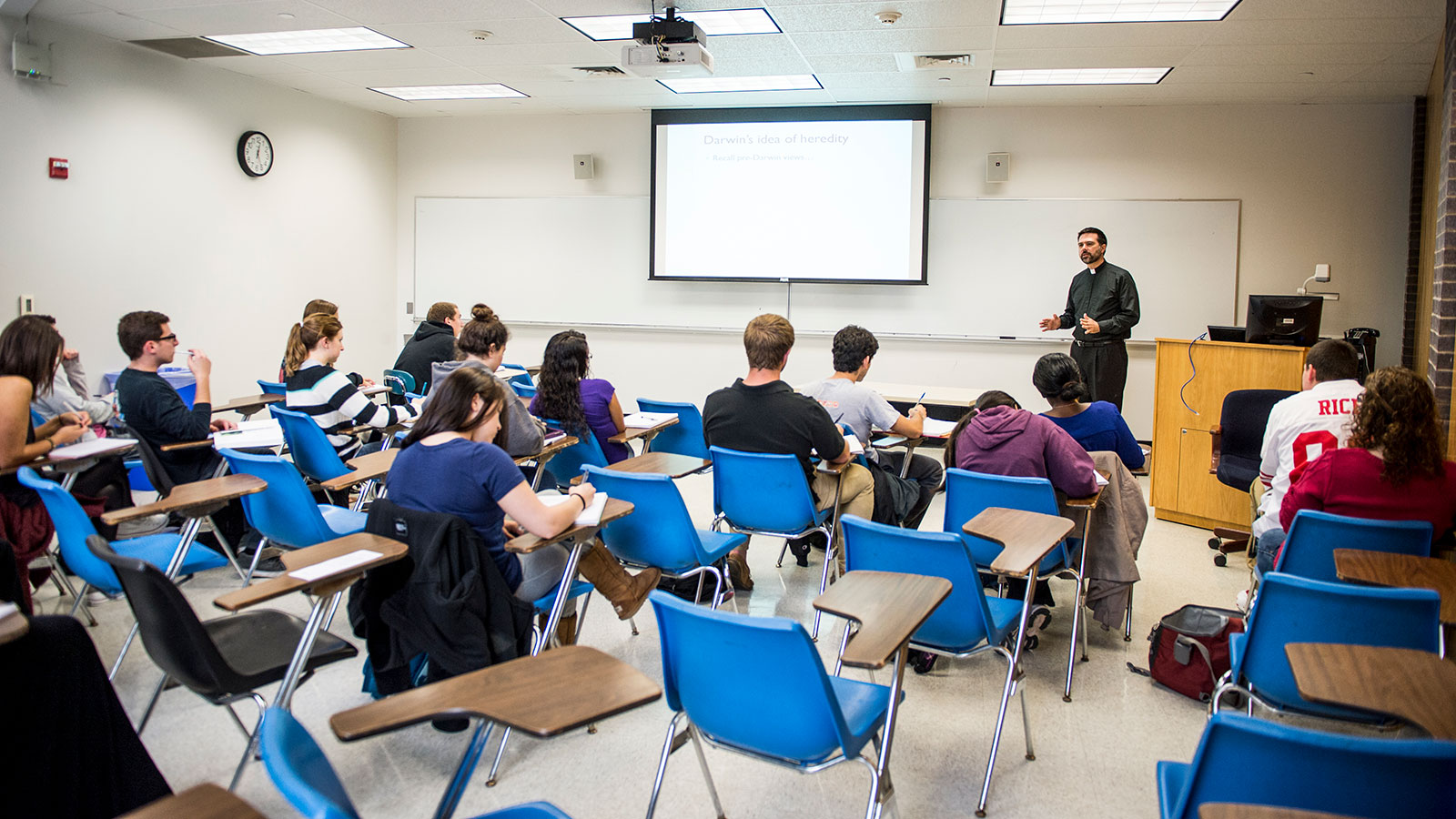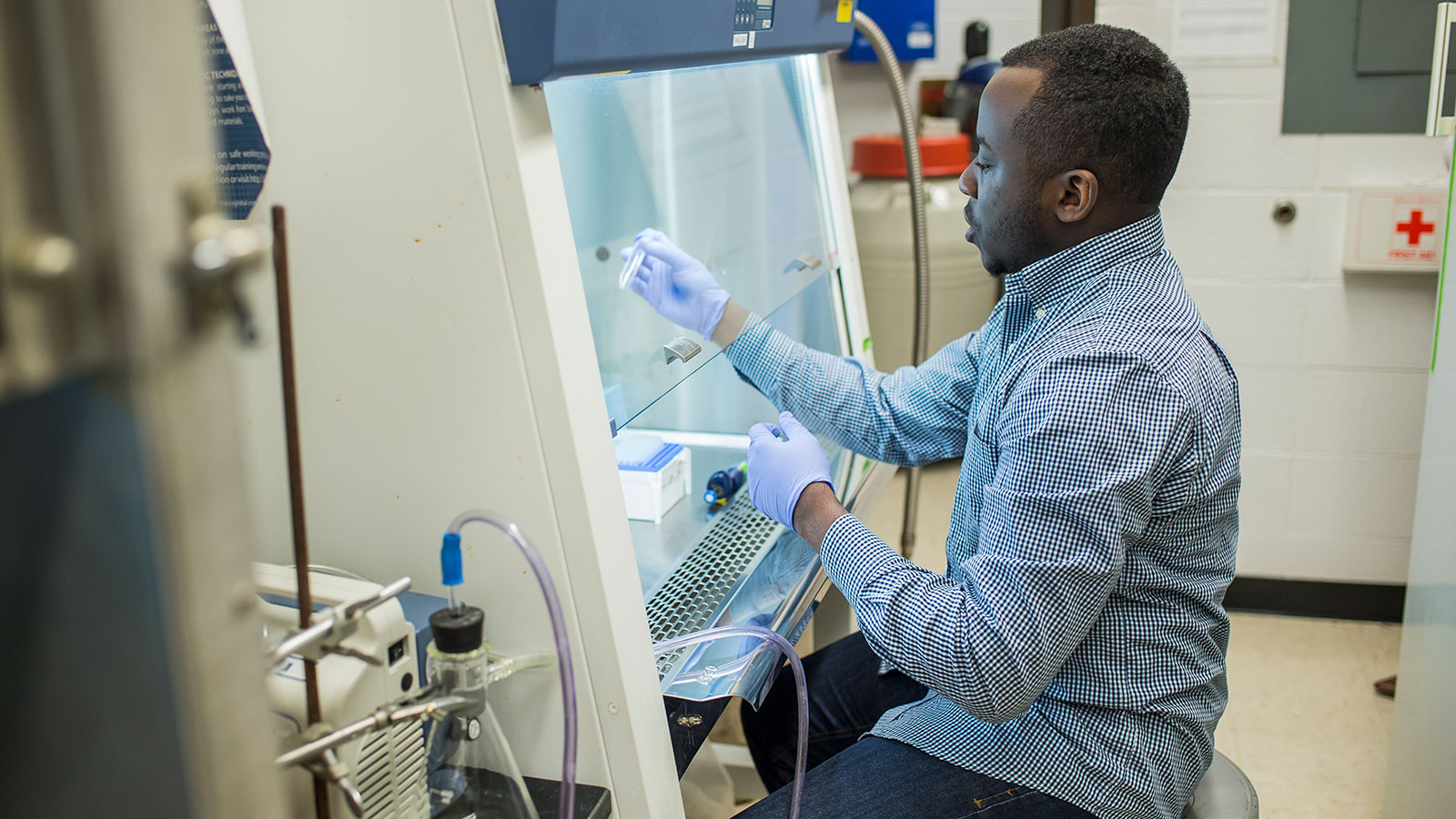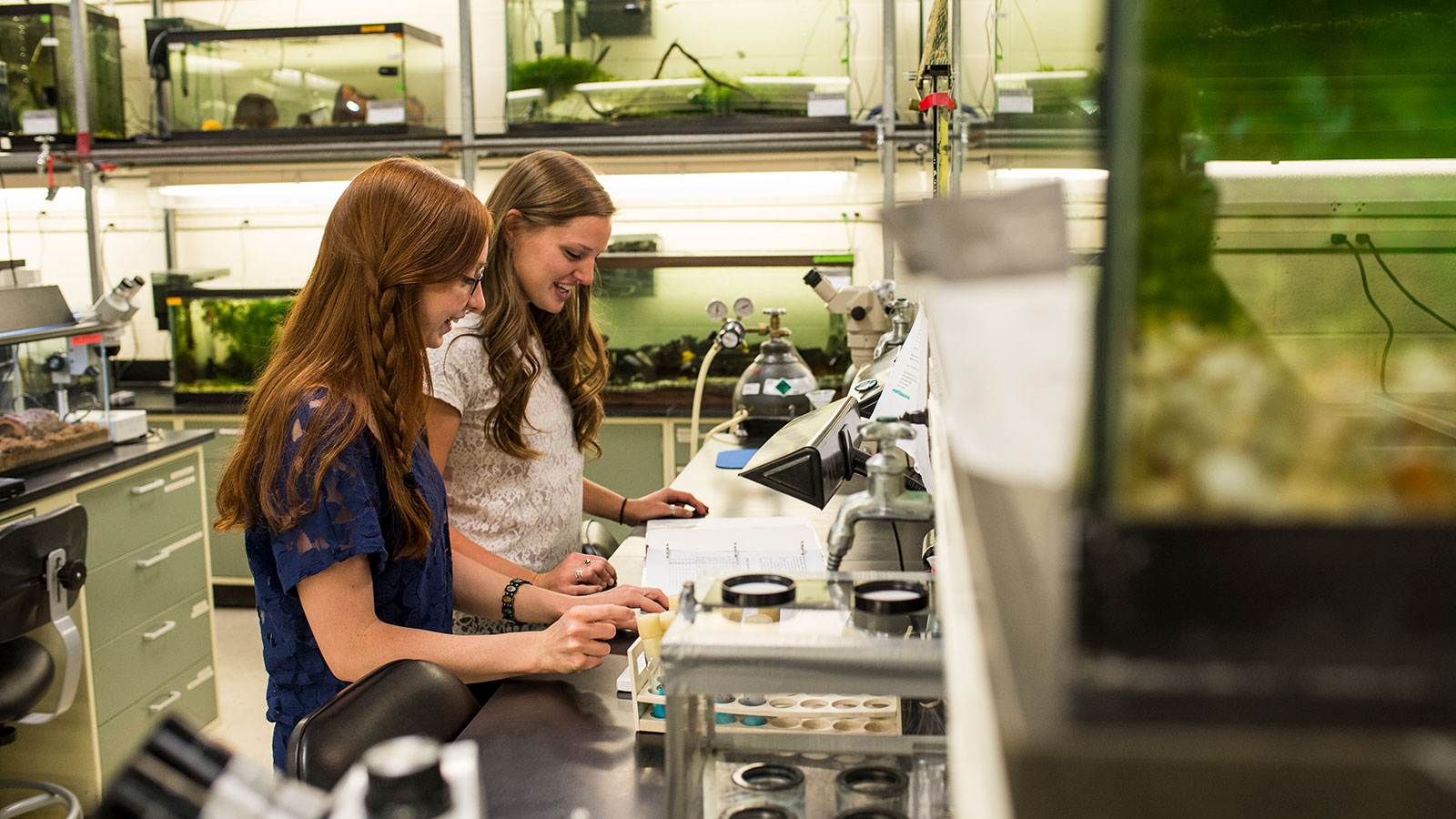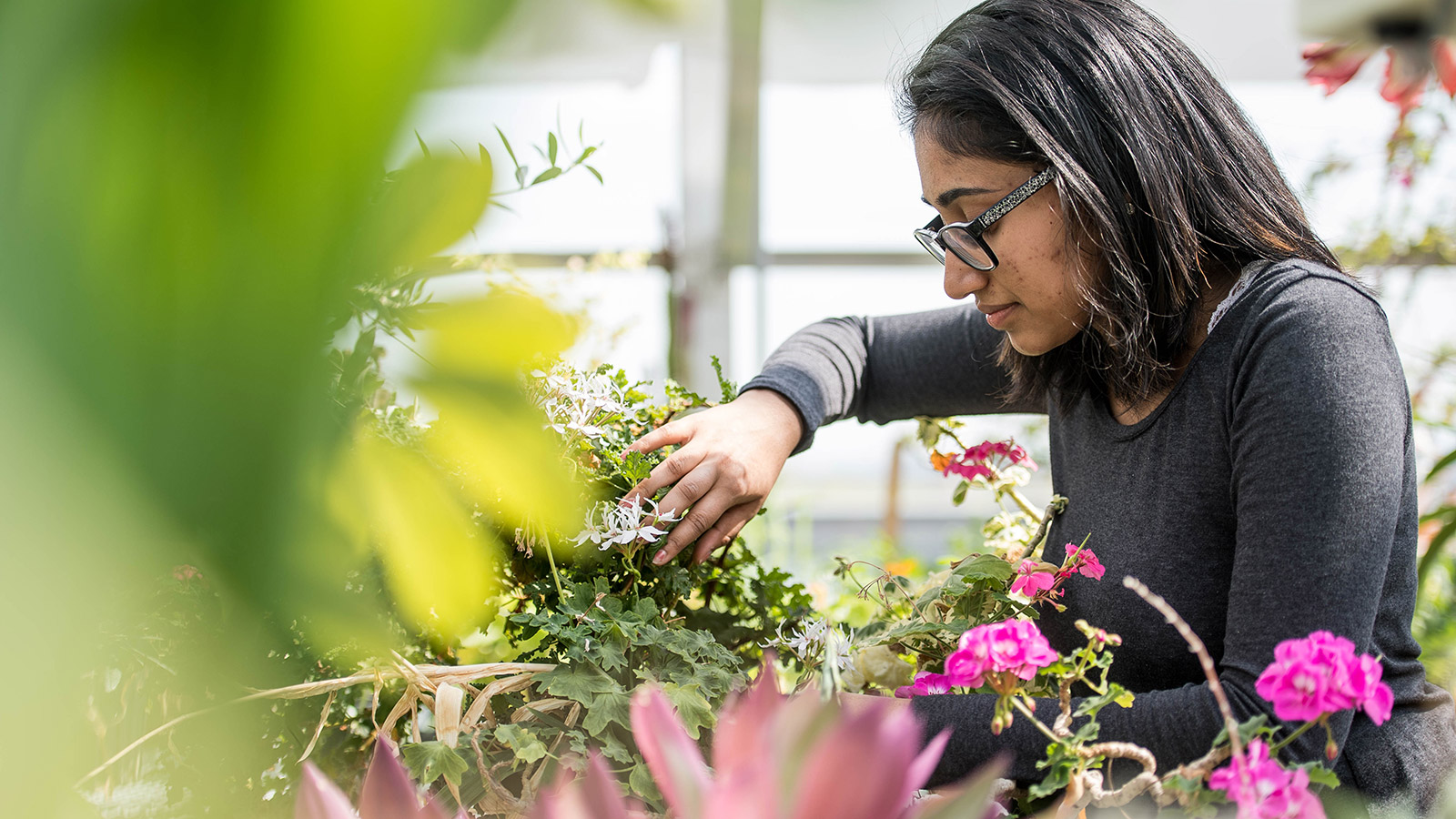Facilities
Classrooms & Teaching Labs

Classrooms
Traditional classrooms are just as important as modern lab facilities in student learning. The classrooms inside the Science Center building range in size and can accommodate various size sections — from 12 seats to 90 seats.
The Science Center Room 200 (SC200) was renovated in the summer of 2015 and now holds up to 100 students. This room is typically used for core courses such as BIO 101 (Bio I: Cells), 102 (Bio II: Genetics) and 201 (Bio III: Organismic Biology). The largest sections in these courses are typically about 30 students in BIO 101 and BIO 102, and 30 to 40 students in BIO 201. Most upper-level biology courses are typically capped at 24 students per section, but most run in the teens to low 20s.
All lecture rooms have internet access available for use during class, as well as built-in computer projection systems used in lectures.
Labs
Most courses offered by the Department of Biology consist of a lecture and lab component. Thus, the Science Center is equipped with laboratory classrooms that fit the needs of courses such as Cells, Genetics, Immunology, Advanced Cell Biology, Systemic Physiology, Neurobiology, Light and Electron Microscopy, Microbiology and Bioinformatics, to name a few. Each lab is between 850 to 1,450 square feet to accommodate up to 12 to 14 students.
Tissue Culture Lab

The tissue culture lab is used to grow animal cells in culture (tissue culture), which is an essential technique in many areas of biology. The lab is used both for course work (in classes such as Immunology, Biotechnology and Advanced Cell Biology) and for student and faculty research projects.
The facility houses:
- Two laminar flow hoods
- Two fully equipped CO2 incubators
- Two inverted microscopes
- A liquid nitrogen cryogenic storage
The Biodiversity Laboratory

The Biodiversity Laboratory at Saint Joseph’s University is a truly unique place devoted to the study of animal behavior, evolution and ecology. To say this lab is unusual would be an understatement as it resembles a small zoo more than a university laboratory. Rather than investigating a single model organism, we study a wide variety of rare and exotic species not typically found in research labs.
University tours often include a stop at the lab, and visitors from outside the school are common. More importantly, school groups of all ages visit the lab throughout the year. Children love the animals and seem to gain a new vision of what science means during their visit. We hope that their experiences at the labs generate excitement about science and the natural world.
The work that happens in the Biodiversity Laboratory primarily falls into four distinct categories:
- Studies on fish
- Studies on amphibians
- Studies on reptiles
- Studies on insects (primarily Drosophila)
You can also view a video tour of the lab and view a list of our publications.
-
Our work with fish is focused on understanding shoaling, or grouping, behavior. While groups of fish are commonly referred to as schools, this is not always correct.
A school is a group of fish that moves in a coordinated fashion. A shoal, on the other hand, is any grouping of fish. Fish join shoals for a number of reasons, including enhanced access to food and mates, as well as protection from predators.
In our lab, we examine the factors that fish utilize when choosing shoalmates, which may include body coloration, pattern, size, shape and shoal composition. In almost all cases, fish shoal with individuals that have features similar to their own. This may lead to benefits associated with the ‘Confusion Effect,’ in which predators have difficulty identifying and attacking an individual within a group of phenotypically similar fish.
We have examined shoaling in a number of different species and are now looking at the effect of experience and learning on shoaling behavior.
Research projects:
- The effects of experience on shoaling behavior in the zebrafish (Danio rerio) and pearl danios (Danio albolineatus)
- The effect of experience on background coloration and pattern selection in zebrafish (Danio rerio)
- Fish Cam
-
Our amphibian work focuses on the influence of factors such as temperature, pH, density and pollution on metamorphosis and survival. Metamorphosis in amphibians, which involves changing from a tadpole to an adult, is an incredibly ‘plastic’ process that can vary tremendously in response to changes in the environment.
We are currently looking at metamorphosis across a wide variety of amphibians, including the beautiful poison frogs of the tropics. We are interested in the potential effects of environmental changes that may result from pollution or global warming. We also run a yearly project in which elementary school children study metamorphosis in American toads.
Research projects:
- The effect of temperature and density on larval development and metamorphosis in the American toad (Bufo americanus)
- Temperature effects on metamorphosis in tropical frogs
-
Our work with reptiles is truly a mixed bag but is devoted, primarily, to the study of turtles.
In partnership with the Turtle Survival Alliance, we currently house assurance colonies of species whose numbers are declining in the wild. We maintain these colonies and catalogue the life history traits (essentially a compilation of behaviors that distinguish one species from another, including feeding behavior, reproductive behavior and growth rates).
We are also involved in a project funded by the Dietrich W. Botstiber Foundation to study the use of turtles in Philadelphia's Chinatown markets. This work, known as the New Life Program, also involves rescuing individual turtles from the markets and bringing them into the Biodiversity Labs.
In addition to our work with turtles, we have also been involved in a long-term study on the ability of iguanas to recognize people. This work began with studies of Fido, an adult green iguana, and continues now with our newest iguana, Nate.
-
Our work with Drosophila involves the analysis of the genetic and evolutionary bases of sexual behavior. Of all the species housed in the labs, Drosophila are the best example of a classic model organism. There is a tremendous body of literature on the genetics, development and molecular biology of Drosophila, accumulated over the 100+ years since Thomas Hunt Morgan first brought these animals into his lab at Columbia University.
Our work goes in a number of different directions, from analyzing the effects of mutations on sexual behavior to surveying the species that comprise wild Drosophila communities.
Research projects:
- An examination of interspecific interactions between different species
- The effects of sleep deprivation on sexual behavior in Drosophilia melanogaster
- Field survey of the Drosophila community in the Philadelphia area
If you have any questions and thoughts, please direct them to Scott McRobert, Ph.D., the director of the Biodiversity Laboratory.
Greenhouse & Green Roof
History
When the Science Center was built in the early '70s, a rooftop greenhouse was included in the building plan. Because of a shortage of funds, the greenhouse was never finished; only the foundation was built.
Paul Tefft, Ph.D., former biology department chair, needed to grow soybean plants to carry out his research, and he built a wood-fiberglass geodesic dome type greenhouse on the roof in 1984. The design came from Popular Mechanics, and Dr. Tefft did all the work on the dome himself. This structure could only be used during part of the year because there was no way to heat or cool it.
Several years later, Dr. Tefft got National Science Foundation (NSF) funding for environmentally controlled plant growth chambers. The dome was still used to grow some plants and as a winter home for some of Dr. McRobert's turtles, until 1995.
In 1996, a glass-aluminum greenhouse, with automatic heating and ventilation, was finally built on the Science Center roof. It was designed and built by Ludy Greenhouses from New Madison Ohio. Karen Snetselaar, Ph.D., who teaches courses in plant biology, is the main user of the plants grown in the greenhouse. However, it is also used by other members of the biology department for teaching and research, and there is potential for wider use by other members of the University community.
Getting the greenhouse designed, funded and built was a major endeavor, and many people contributed in various ways. We are particularly grateful to the following people for their help:
- Vincent McCarthy, Ph.D., who was Provost at the time that the greenhouse was built, for providing funds and other support.
- John Tudor, Ph.D., former head of the biology department, for helping with fundraising and logistics.
- Paul Tefft, Ph.D., of the biology department, for helping with the logistics.
- Michael McCann, Ph.D., of the biology department, for helping with decision-making, dealing with permit problems, midnight drives for emergency heaters and a host of other things.
- Al Sgro, of Sgro Plumbing, went beyond the call of duty to help get the greenhouse built.
- SJU Facilities Management for helping with construction decisions.
Plants in the Greenhouse
Saint Joseph's greenhouse functions mainly as a place to house the collection of plants used in teaching biology courses. There is quite a variety of non-flowering plants such as ferns and gymnosperms, that are used for the Organismic Biology course. There are representatives of many families of flowering plants, used for the Plant Systematics course. Research plants, mainly corn and soybeans used by Dr. Snetselaar and Dr. Tefft, are also grown in the greenhouse.
Tour the Greenhouse
If you'd like to take a personal tour of the greenhouse, please contact Dr. Clint Springer in the biology department.
McNeil Science and Technology Center

The McNeil Science and Technology Center at Saint Joseph's University City location includes the following:
- 13 research laboratories of 200 to 600 square feet each
- Numerous shared equipment and specialty rooms
- Three computer classrooms
- A computer work workroom
- Eight teaching laboratories
- A 400-seat auditorium
- Three smaller classrooms
- Sufficient office and meeting space for faculty members, research assistants and graduate students
The building also includes small core facilities focused on studies of proteins, protein-nucleic acid interactions, microscopy and molecular biology.
